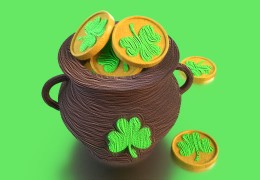
Discover how to make eco-friendly crafts with a 3D pen this St. Patrick's Day! Get inspired with various project...

Nowadays, 3D pens are trendy. They allow you to realize a wide variety of design fantasies and contribute to the development of imagination, especially in children. Nevertheless, for the operation of such equipment requires unique filament materials. The most popular plastic types are ABS and PLA. Which one should you prefer?

Petroleum is the base of this material. During heating, ABS emits a distinct smell of burnt plastic, so you need to work with it only in a well-ventilated room. Products made from ABS are durable and resistant to mechanical stress, including light bending. Besides, the material is slightly affected by chemicals. However, ABS does not tolerate moisture and ultraviolet rays. Plastic has a low stickiness, which, still, is sufficient for drawing on paper. The surface of the hardened plastic is usually glossy and shiny.
There are several options for ABS used in various fields, each of which has its unique features. However, several features correspond to any ABS filament: it has excellent impact resistance, outstanding thermal and chemical strength, is durable, and is easily post-processed to get a glossy and smooth look.
Thanks to an impressive array of physicochemical characteristics, ABS quickly gained popularity as one of the most demanded engineering plastics. In the 3D printing application, ABS is definitely between the two most admired materials due to its unbeaten stability and low price.
1. Tough and impact resistant
Compared to PLA, ABS is much more durable and obtains higher impact resistance. If you need to create things that have to perform mechanical functions and will wear out a lot, then ABS is a reasonable choice of material.
ABS also has tremendous chemical resistance, which makes it indispensable in different commercial and technological applications. This quality can be beneficial for creating everyday 3D art objects. The absolute multifunctionality of ABS is perhaps one of the arguments why it remains a popular filament for 3D printing, despite its drawbacks (which we will talk about later).
2. High melting point
ABS is suitable for high-temperature applications because it melts at a much higher temperature than PLA. ABS is great for items that do not come in direct contact with hot food, or things that you designed for using or displaying outdoors. Since ABS melts at about 200 ° C, your object will not melt even on the hottest days.
3. Post-processing by acetone
We already know that ABS has excellent chemical resistance. However, there are still a few solvents before which the ABS is losing ground. For example, ordinary household acetone easily dissolves ABS. Although this may be considered a limitation of ABS, the rapid prototyping industry has turned this into an advantage. It uses acetone as a finishing agent for models made of ABS.
The use of acetone is beneficial in smoothing defects on the surface of an ABS product, although this method requires specific skills. You can use acetone to create individual parts from ABS, constructed using a 3D pen, which serves as a kind of “glue” that instantly melts plastic. Since acetone connects parts of the ABS at the molecular level, these bonds are as strong as the rest of the product.
1. ABS emits toxic fumes during drawing.
ABS is known for emitting fumes that have an unpleasant odor when heated. This odor is not just an annoyance. Researches have shown that ABS releases styrene, a known carcinogen. Thus, it is worth thinking about good ventilation when working with ABS plastic. When drawing with a 3D pen, do not forget that you should be close enough to what you are doing, so avoiding all these fumes is much more difficult.
We recommend working in a well-ventilated area and wearing respiratory protection. Suffering from your art is already out of fashion.
2. Non-biodegradable
More and more people think about environmental safety day after day, especially when it comes to products that they buy and use. This new trend has quickly gained momentum in the last couple of years. Of course, there is nothing wrong with that. With this changing mindset, unstable and non-recyclable materials quickly go out of fashion. As supposed, ABS is for sure such material.
ABS is made from non-renewable petroleum products. It takes millions of years to dissolve ABS completely, but even after destruction, the by-products of its decay are poisonous and toxic to the environment.
Manufacturers can recycle ABS to create new filaments or other types of plastic products. Nevertheless, recycling is costly and cannot be done endlessly for the same plastics. So, as long as people continue to use ABS, manufacturers will continue to produce it and eventually throw it away.
However, these properties do not affect the quality of the material. ABS is a good filament for 3D pens. Depending on your personal opinion, you can decide on whether to continue using ABS.
At the heart of this plastic is a variety of plant components. It is made from cornstarch or soy. This material is not as common as ABS but is gradually gaining more and more popularity. An important advantage of PLA is the absence of odor. Most often, only a sweetish aroma can be distinguished when heated. This plastic is also quite tough but more fragile. When bent, it can break. It has greater adhesion, so using PLA, you can draw not only on paper but also on other materials, including ceramics, metal, and glass. Such plastic can have the most diverse appearance. There are translucent and even glow in the dark options.
The base of PLA is a polymer made from building blocks of lactic acid. The lactide raw material used for PLA polymerization is derived from sugar or corn, making it one among the few plastics that can be manufactured sustainably. After the destruction, PLA decomposes again into lactic acid, which is safe for both the environment and the human body.
Due to its biodegradability, PLA has become one of the most commonly used alternatives to traditional, non-biodegradable plastics. The increase in the use of PLA made it plastic with the second-largest rate of world production.

1. Biodegradable
The art of drawing with a 3D pen, unfortunately, became popular only at a time when most of the world realized our problem with plastic waste and is working to reduce plastic waste. There is also the problem of producing most plastics from petroleum sources, which, as we know, are currently not sustainable.
Using PLA, you can facilitate guilt over the global problem of plastic garbage. PLA is 100% biodegradable and made from environmentally friendly raw materials. If you use 3D pens for teaching using PLA, you give two lessons at the same time: your students not only get the opportunity to practice their 3D drawing skills but also recognize the importance of adopting environmental principles.
2. No smell during the drawing
PLA does not emit any toxic fumes or any smell when heated. This property makes it a much safer alternative to many other filaments. This is one of the main reasons for choosing this plastic for children.
Although PLA is one of the safest filaments to work with, some precautions are still needed. In the end, heating the plastic and squeezing it through a tiny hole can release plastic microparticles into the air, which you can inhale. We recommend using some respiratory protection, although working with a 3D pen in a well-ventilated area will be sufficient.
We also should note that although PLA base plastic may be non-toxic, some suppliers may add dyes with toxic components. For your safety, check with the manufacturer of your plastic.
3. Easy to draw on different surfaces
Another PLA feature that makes it great for creative builds is its remarkable adhesion. Good adhesion is great if you want to use a 3D pen to decorate a ceramic bowl or glass surface. Although other options outperform PLA in stickiness (e.g., TPU) due to its excellent adhesion and easy accessibility, PLA is still a great choice.
1. Low melting point
The low melting point of PLA is one of the most distinctive characteristics that also make it easy to work with. On the other hand, this also means that PLA products cannot withstand high temperatures. Leaving a PLA model inside the car on a sunny day may be enough to deform it severely.
This limits the reasonable use of PLA assemblies. If you are trying to put the decoration on a ceramic bowl designed for hot food or drinks, then you probably should not consider PLA for your material.
PLA is also not suitable for facilities intended for outdoor use.
2. Insufficient strength and flexibility
PLA is a hard material, but keep in mind that, unlike ABS, it lacks flexibility. If you try to bend your product, it most likely will break. Keep this in mind when designing your model. This plastic is not very suitable for products with moving parts.
3D pens are incredibly interesting for both children and adults, and they can be used to create simple drawings or amazingly complex works of art. This technology has existed not so long ago, so the options for their use continue to change and develop. ABS and PLA, the two most popular 3D pen filaments, are a trend that has probably been ported from the wider FDM printing industry, but this does not mean that you need to limit yourself to one or the other.
Both ABS and PLA have their pros and cons. ABS is much more durable, and PLA is more environmentally friendly plastic. It all comes down to how you use your 3D pen, what you hope to create, and your personal beliefs.
Latest comments